Neil Young's "Tonight’s The Night" 50th Anniversary Deluxe Edition Due
limited edition includes 6 unreleased tracks from the original sessions
Fifty years after Neil Young recorded Tonight’s The Night, to mark the half-century milestone, Young has announced a limited deluxe 50th Anniversary edition of the 1975 LP, complete with six bonus tracks drawn from the original 1973 recording sessions.
Released in June 1975, Tonight’s The Night was recorded on analog tape during August-September of 1973 at Studio Instrumental Rentals (S.I.R.) on Santa Monica Blvd. in Hollywood.
Musicians: Neil Young – piano, vocal; Nils Lofgren – guitar; Ben Keith – pedal steel guitar, vocal; Billy Talbot – bass; Ralph Molina – drums, vocal. The album was produced by David Briggs and Neil Young with Tim Mulligan.
Young and Elliot Mazer are co-producers on "Lookout Joe" which was recorded at the studio in Young’s Broken Arrow Ranch in December 1972. Musicians: Neil Young – guitar, vocal; Ben Keith – slide guitar, vocal; Tim Drummond – bass; Jack Nitzsche – piano; Kenny Buttrey – drums.
1973 began with a concert in Milwaukee, on January 5th. Linda Ronstadt was the opening act. Three months of dates in cavernous arenas were booked for Young’s new Time Fades Away band whose stage repertoire almost entirely consisted of all Young un-heard copyrights. Drummond and Buttrey provided the rhythm, Ben Keith stoked the engine and Mr. Hyde, Jack Nitzsche, tinkled the keys.
Young’s shows with Crazy Horse, in the summer and fall of ’73, featured songs that would comprise Tonight’s The Night. David Briggs was back, helming the production, riding shotgun on the tour, another juvenile delinquent running away to join the circus.
The concerts were as much performance art as they were exercises in rock ‘n’ roll mayhem. Young, himself, adopted a vaguely gonzo persona, part Nicholson’s Joker, part wasted hipster. The band was equally disordered, rude, crude and happy to throw a punch without any provocation.
I attended the opening of the Roxy Theatre on Sunset Blvd. on September 20, 1973 where Young and his boys were booked.
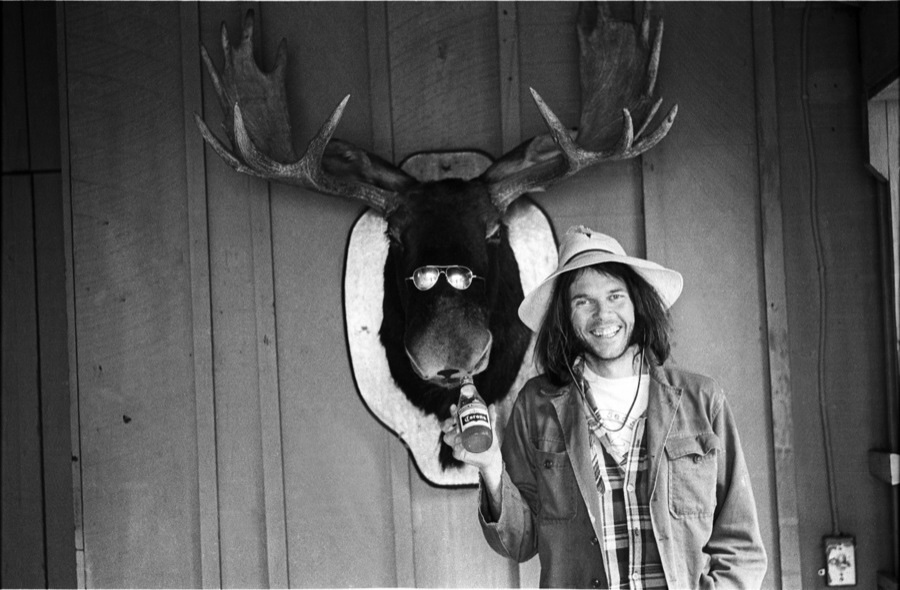 1975 photo by Henry Diltz, courtesy of Gary Strobl at the Diltz Archive.
1975 photo by Henry Diltz, courtesy of Gary Strobl at the Diltz Archive.
Nils Lofgren remembers this time as a raucous party designed to drown out the lingering darkness with over-amped intensity. Bruce Berry, a long-time crew member held in loving esteem, had checked out prior to hitting the road – the needle had done its damage once again.
In a 2014 correspondence for my book Neil Young: Heart of Gold, musician/singer/songwriter Steve Wynn commented on hearing the LP in 1975.
“I bought Tonight's The Night when I was 15. I had heard ‘Heart of Gold’ on the radio a year or two before that. Who knows? Maybe I thought I'd be getting more of the same. I still remember hearing Tonight’s The Night for the first time late at night after I had turned off the lights to go to bed. I had never heard anything like it and was mesmerized. I mean, I was already a fan of some heavy, underground rock--my favorite bands at the time were the Rolling Stones, the Who, Alice Cooper--things like that. But I had never heard anything that was so willfully broken and raw and so wrong in such a right way. I had never heard music so human and honest and both beautiful and terrifying.”
To commemorate the 50th anniversary of the album, six bonus tracks have been added to this limited-edition item. Many unique numbers have been gathered to create the definitive edition of what many have called the third and final installment of The Ditch Trilogy.
1975 was a historical time, and Tonight’s The Night reflects that. These were turbulent milestones, which saw the end of the Vietnam War, a new president in the White House but nothing would affect Young more than the untimely and tragic passing of two close friends, original Crazy Horse guitarist/vocalist Danny Whitten and devoted road crew member Bruce Berry.
In some ways, Neil Young's music fifty years later is still growing from all that was inspired from the 1975 time of Tonight’s The Night.
Included on the new 2025 release are unreleased original versions of "Lookout Joe" and "Walk On," both recorded during the initial 1973 album sessions at S.I.R. "Lookout Joe" replaces the first released album version that was cut at Young's Broken Arrow Studio and included in Tonight’s the Night original pressing.
"Lookout Joe" and "Walk On" fit well with the original Tonight’s The Night LP, recorded in the same sessions. There are six bonus tracks on the 50th anniversary products. These versions of "Lookout Joe", "Walk On," and "Tonight's The Night" (Take 3) have never been issued. "Everybody's Alone," "Raised on Robbery" (featuring Joni Mitchell,) and "Speakin' Out" Jam appeared in Neil Young Archives Vol II, while the unreleased TTN version of “Wonderin'” from the same sessions has only ever been available to stream on Neil Young Archives (NYA). This is the first time all six bonus tracks from the original sessions have been available on vinyl, making this the most cohesive and true version of Tonight's The Night.
Tonight’s The Night 50th Anniversary edition Track Listing:
“Tonight’s The Night”
“Speakin’ Out”
“World On A String”
“Borrowed Tune”
“Come on Baby Let’s Go Downtown,”
“Mellow My Mind”
“Roll Another Number (For The Road)”
“Albuquerque”
“New Mama”
“Lookout Joe [New 1973 version]”
“Tired Eyes”
“Tonight’s The Night (part II)"
Bonus Tracks - all from original TTN sessions at S.I.R.:
“Walk On”
“Wonderin’”
“Everybody’s Alone”
“Raised on Robbery” [feat. Joni Mitchell]
“Speakin’ Out Jam”
“Tonight’s The Night (take 3).”
The 50th Anniversary Deluxe limited edition will be released on vinyl, CD and digitally. A clear vinyl format is available at Greedy Hand Store and indie retailers. The original artwork has been creatively reimagined for this limited-edition configuration.
All formats will be available at the Greedy Hand Store at Neil Young Archives (NYA) and music retailers everywhere. Hi-res digital audio will be at Neil Young Archives and most DSPs. All Greedy Hand Store purchases come with free hi-res digital audio downloads from the NYA Download Store at NYA.
In 2014 I interviewed Gary Stewart, the former VP A&R executive for Rhino Records about Neil Young. Here are a few excerpts:
“We were involved only peripherally with the release of the [2001] Buffalo Springfield box. Neil Young was somebody we always talked about as the gold standard for how to be a veteran artist without falling into the classic rock coffin that engulfed so many of his peers.
“If you look at that elite group the veteran artists started in the rock 'n roll idiom still making diverse music that matters by looking forward and telling the truth- Elvis Costello, Patti Smith, Tom Waits-it’s hard not to think of Neil as the first person that set the example for having perspective and legacy without losing edge-that he was built for speed and distance,” summarized Stewart.
During 2014 I interviewed Nils Lofgren for Neil Young: Heart of Gold.
What did he learn from Neil Young, David Briggs and Jack Nitzsche about record making?
“The bottom line was Neil Young, David Briggs to start and then Jack Nitzsche, I learned early on that you must be authentic and passionate about what you are doing first. At all costs. You must never let go of that. In my band Grin and then with Neil, David was in our corner musically. He would chase the David Geffens and Eliott Roberts out of the room. He’d say, ‘Get out of here. We’re not talkin’ business!’ And they were like, ‘Look, man. This is our artist.’ They blackballed him from a million projects and he didn’t care.
“David was the guy who burned every bridge with the executives. And he didn’t care. He was like, ‘I know you have to talk to Neil Young about business. You’re not doing it when we’re making music. Get out!’ And that was his mantras. ‘We’re making music and take that shit out of here.’
“It made a big impression because Neil Young is a brilliant business man and he’s gonna talk to those guys. But even Neil can’t do that hard ass with people he has to work with to put his music out and have a guy like David, sayin’ what everyone wanted to but couldn’t and be that productive and keep the focus so authentically about the music and the passion. I hung on to that through every (record) company, every producer, every situation. I continued on with what I learned from Neil, David and Jack, with Crazy Horse. Be authentic. Be excited and engaged and remain passionate about it all costs. And with that honesty the rest will work out.
“I was blessed to have started with Neil and David, and soon after, Jack Nitzsche, Danny Whitten and Crazy Horse. Just that authentic honesty and optimism about thinking big about what you’re doing and dream big,
“The legacy of Crazy Horse? Well, you know, Danny Whitten, from the day I met Crazy Horse and Neil Young at the Cellar Door in 1968 or ’69 on their first tour, it was common knowledge, and Neil would be the first to tell you, that Danny was like one of his early mentors and influences, with that great deep ‘Bee Gees’ vibrato, with that California soul and lament.”
“Danny Whitten, in the Crazy Horse sound equation, was the heart and the soul,” emphasized veteran record producer/ artist manager Denny Bruce in a 2015 interview.
“Danny was an incredible rhythm guitarist. And his voice is featured on ‘Cinnamon Girl’ with Neil singing. You’re able to hear Danny’s high voice with balls and the bottom end warmth and then Neil’s bottom but still high pitch on top. But mixed well enough that you can’t tell it’s two guys singing.
“In 1966 I first met Neil when he was living at the Commodore Gardens in Hollywood. I saw Buffalo Springfield play all the local clubs. At the Whisky, Gazzarri’s and smaller places. After performing Neil would go to his apartment still wide awake and write songs. That to me was his real fertile period.
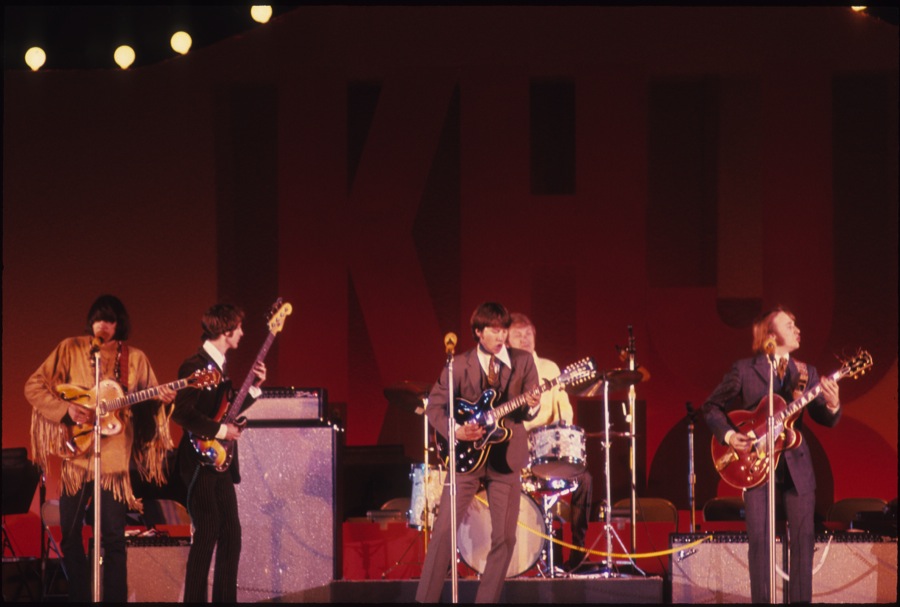 Buffalo Springfield Hollywood Bowl Photo by Henry Diltz, Courtesy of Gary Strobl at the Diltz Archive
Buffalo Springfield Hollywood Bowl Photo by Henry Diltz, Courtesy of Gary Strobl at the Diltz Archive
“I saw Buffalo Springfield open for the Rolling Stones in 1966 at the Hollywood Bowl. They didn’t have a stage presence like Moby Grape. They worked at sounding a little more country than most rock bands at that time. Instead of getting more dirtier and rock, like Neil wanting to be able to play more like Keith Richards. His role was kind of diminished by having too many other guys in the band who wanted more microphone time.
“I was living with Jack Nitzsche from 1965-1968 at his house on Mulholland Drive. Neil liked Jeff Beck. For hours in his Laurel Canyon cabin where Neil lived, he tried to get the ‘Jeff Beck’ sound out of his little Princeton Fender amp. He dug ‘Hi Ho Silver Lining’ and the flip side ‘Talley Man.’ Neil didn’t have a whole lot of records but had the first Lonnie Mack album The Wham of That Memphis Man! He knew every fuckin’ note of that LP and you’ll hear them in Neil Young soloing.
“I had played drums with producer David Briggs earlier with Simon Stokes on bass. We did Top 40 gigs. A singles place in Burbank called The Never on Friday club. No married couples allowed. You had to prove you weren’t married. In the Pickwick Entertainment area. So, I knew David before he knew Neil Young,” recalled Denny.
“I also went to Neil’s solo 1971 Dorothy Chandler Pavilion solo gig with Jack. Neil’s voice was really connecting with people then. Michael Bloomfield called it, ‘Return to the womb rock.’ James Taylor, Neil and just a handful of guys were allowed in and girls just loved it. And Neil was also able to rock so that the guys could dig him and Crazy Horse playing loud.
“I saw Neil again at his ranch in the early seventies a couple of times. Neil had a new amp set up. ‘Oh Denny. Let me play you something.’ He had these two amps connected, ‘tell me if you like this sound.’ He blasted it and had that ‘Jeff Beck’ thing. I told him it was really a good set up.’ He went, ‘thank you. I really appreciate it when you tell me the truth.’”
“When I was part of the band, it wasn’t Crazy Horse,” remarked Nitzsche in one of our 1988-2000 interviews.
“I sort of took over and became the producer and made them sound much better than they actually were. ‘Gone Dead Train’ was done, but I prefer the version on Performance by Randy Newman. Someday, somebody will stop and listen to that song I wrote with Russ Titelman at my house on Yucca Trail. I was on tour years ago with Neil Young and Crazy Horse. Miles Davis opened for us! Fillmore East. I thought it was an insult to Miles.”
Recording engineer and producer Elliot Mazer worked with Kenny Burrell, Chubby Checker, Maynard Ferguson, Richie Havens, Janis Joplin, Neil Young, Linda Ronstadt, Bob Dylan, Jack Nitzsche, Crosby, Stills, Nash & Young, and The Band.
I interviewed Elliot in 2015.
“I knew ‘Heart of Gold’ was a hit when Neil played it. His songs are generally an overpowering feeling. I’m in the control room. Small space. 12 feet by 20 feet. And Neil plays ‘Heart of Gold’ and I look up and [drummer] Kenny Buttrey and I both at the same time put our fingers up as number one. We knew it. From then it was only a matter of time to get the thing done properly and out. Neil’s singing and playing on it was magnificent. His tempo was perfect. It was great. All we had to do was make sure we didn’t mess him up. I used a Neumann U67 or 87 microphone on his voice and rode his sound levels.
"We did other tracks that were taped with the Stray Gators, as the guys were now called, in California in a barn on Neil's ranch. We used a mobile truck with a UREI tube mixer. 'Words', 'Alabama' and 'Are You Ready for The Country.' Neil played electric guitar. Jack Nitzsche was on these sessions. Jack was a great and interesting person to talk and work with. I have nothing but good things to say about him.
"In Nashville we recorded to 16-track at Quad. Going to Neil's ranch was the same to me as working in London or New York. Neil wanted a studio like Quadraphonic. He had already built a building so he got the same console that we had and similar tape machines. 'Words' and 'Alabama' and 'Are You Ready for the Country?' were cut down in his barn. We used the Wally Heider remote truck for that.
"For the Harvest album, Neil recorded 'The Needle and the Damage Done' from a solo tour concert at UCLA's Royce Hall and two Jack Nitzsche arranged orchestral pieces that Glyn Johns engineered in London at Barking Town Hall that I mixed.
“Neil in the studio is magnificent when he wants to. When Neil is at a point where he really delivers a song wonderfully, it's incredible. Live is different. He sings louder live than he does in the studio. Neil Young can play guitar and sing. You can put a microphone at the voice and a microphone at the guitar and you won't hear anything but voice and guitar. He is a master of playing guitar at appropriate levels. I think it come from him playing a lot of clubs and wanting the guitar to be heard. That would be my guess.
"Janis and Neil are extraordinary people. I mean, they are unique and sound like nobody else. They were doing something that was really original and people either liked it or didn't pay attention. I think Neil and Janis were really smart people. Above-average smart people. You don't become the success in this business without being really bright, by the way. You can't do it all. And Janis and Neil would do it all.
“Janis was really interested in every aspect of making records. People keep referencing her sexuality. But in fact, she was an incredibly smart person that would really care about something and would work incredibly hard.
"Neil works hard and is a very interesting person. I think that's it. And his music moves people. Because they see an artist that they like, and they've liked, and see something positive that they recognize, and they know it gives them a very good emotional response listening to that. People want to feel good. And I think Neil does it,” Mazer underlined.
During 1997, I interviewed filmmaker Jim Jarmusch in a West Hollywood hotel when he was touting his documentary on Neil Young & Crazy Horse, Year of The Horse.
“Crazy Horse tend to be overshadowed by, not by his own design but that’s just the way it is. And one aspect of Year of The Horse was to make those guys known as people a little bit, so we understand them as a band, and not just as Neil Young’s backup, side musicians.
“I began to realize they were a four-piece band when I started shooting Big Time. I’ve always been a big fan of Neil, particularly with Crazy Horse on album like Tonight’s The Night or On the Beach. I like the more dark rock ‘n’ roll side of Neil. I think he’s a great.
“I’ve been a big fan since I was a kid. I first heard the song “Broken Arrow” by Buffalo Springfield, which was very visual and dreamlike to me. I didn’t know what the lyrics meant, so I invented my own scenario. After that, the next big thing that went right into me was the first Crazy Horse record, Everybody Knows This Is Nowhere. So, I’ve been a big fan all along, but had never seen Neil live until the late ’80s. The good stuff always held up. That’s why we listen to Bach.
“He’s a real poet, but not in an extravagant way. I mean, he uses very common language, but it becomes poetic in the economy. Things are not over-explained. And what really kind of blew my mind was, after I hung out with Neil at his ranch, I realized certain lyrics that were very abstract to me I then saw, or had some insight into what, literally, they were all about,” marveled Jarmusch.
***********
(Harvey Kubernik’s Neil Young: Heart of Gold 2016 book has been translated into six foreign language editions. He is the author of 20 books, including 2009’s Canyon Of Dreams: The Magic And The Music Of Laurel Canyon, 2014’s Turn Up The Radio! Rock, Pop and Roll In Los Angeles 1956-1972, 2015's Every Body Knows: Leonard Cohen, and 2017's 1967: A Complete Rock Music History of the Summer of Love. Sterling/Barnes and Noble in 2018 published Harvey and Kenneth Kubernik’s The Story Of The Band: From Big Pink To The Last Waltz. In 2021 the duo wrote Jimi Hendrix: Voodoo Child for Sterling/Barnes and Noble.
Otherworld Cottage Industries in 2020 published Harvey’s Docs That Rock, Music That Matters. His Screen Gems: (Pop Music Documentaries and Rock ‘n’ Roll TV Scenes) is scheduled for a 2025 publication. Harvey wrote the liner notes to CD re-releases of Carole King’s Tapestry, The Essential Carole King, Allen Ginsberg’s Kaddish, Elvis Presley The ’68 Comeback Special, The Ramones’ End of the Century and Big Brother & the Holding Company Captured Live at The Monterey International Pop Festival.
During 2006 Kubernik appeared at the special hearings by The Library of Congress in Hollywood, California, discussing archiving practices and audiotape preservation. In 2017 he lectured at the Rock and Roll Hall of Fame in Cleveland, Ohio, in their Distinguished Speakers Series and in 2023, Harvey spoke at The Grammy Museum in Los Angeles discussing director Martin Scorsese's The Last Waltz music documentary.
Kubernik was interviewed in the 2025 documentary, The Sound of Protest currently onthe TVOD Apple TV broadcasting service. https://tv.apple.com › us › movie › the-sound-of-protest. Director/writer Siobhan Logue’s endeavor features Smokey Robinson, Hozier, Skin (Skunk Anansie), Two-Tone's Jerry Dammers, Angélique Kidjo, Nina Simone, Holly Johnson, David McAlmont, and Rhiannon Giddens).


-2.png)




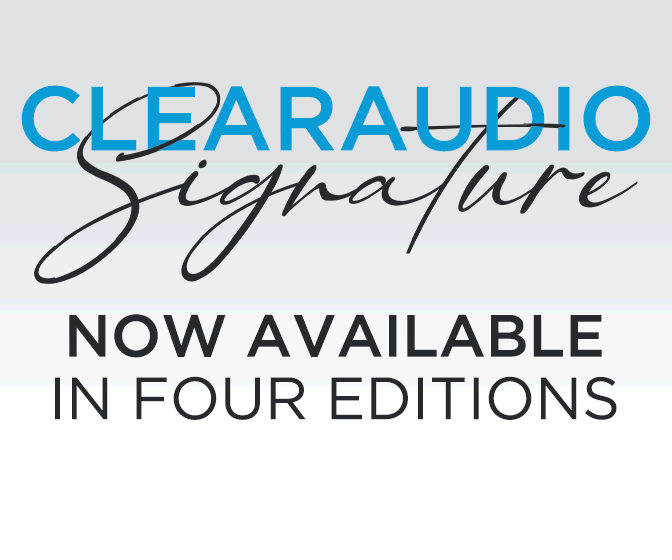

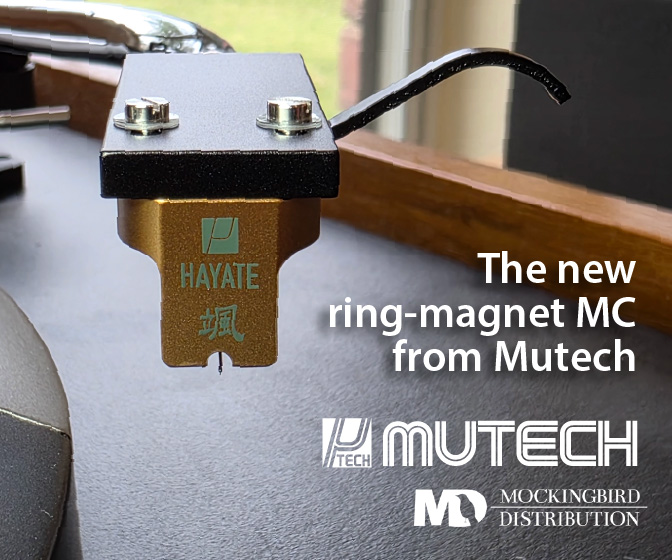
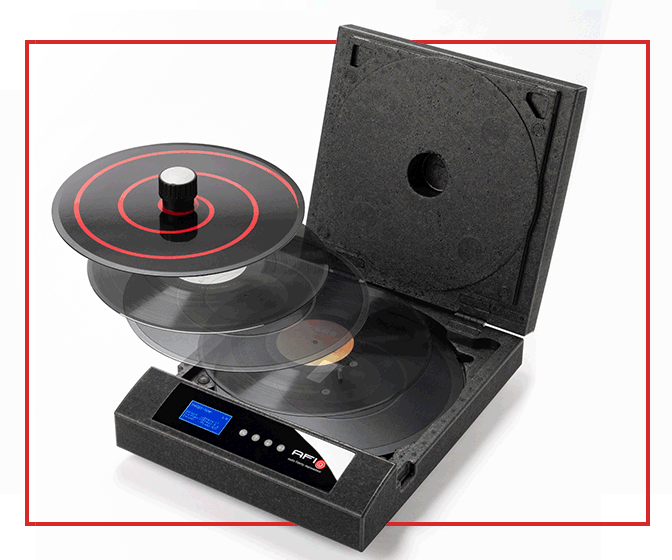
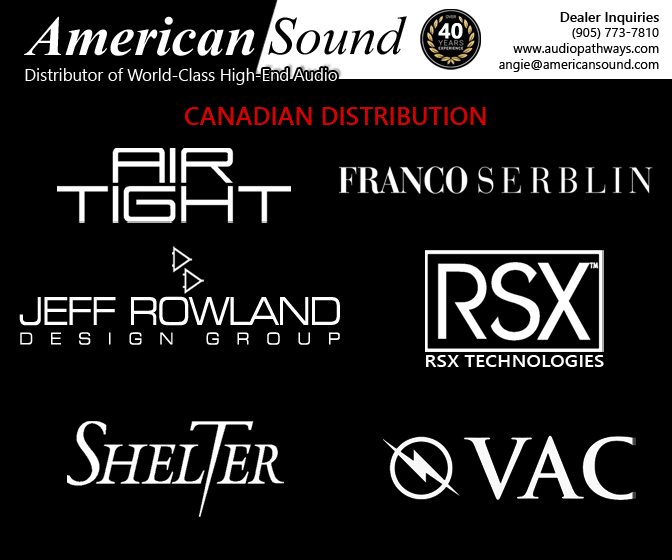
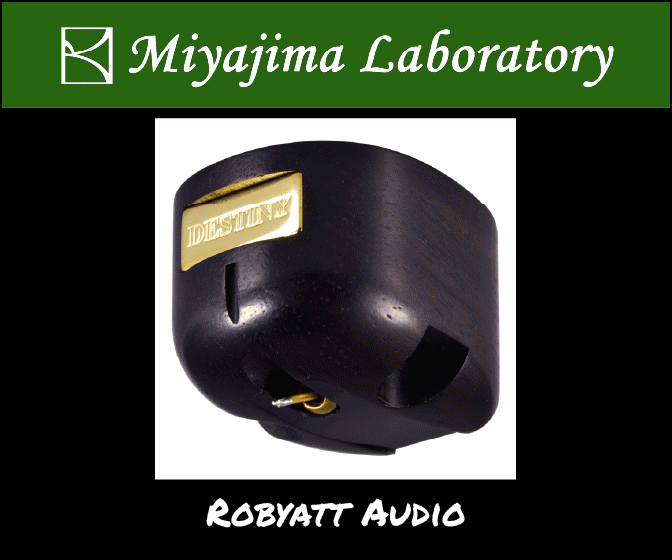
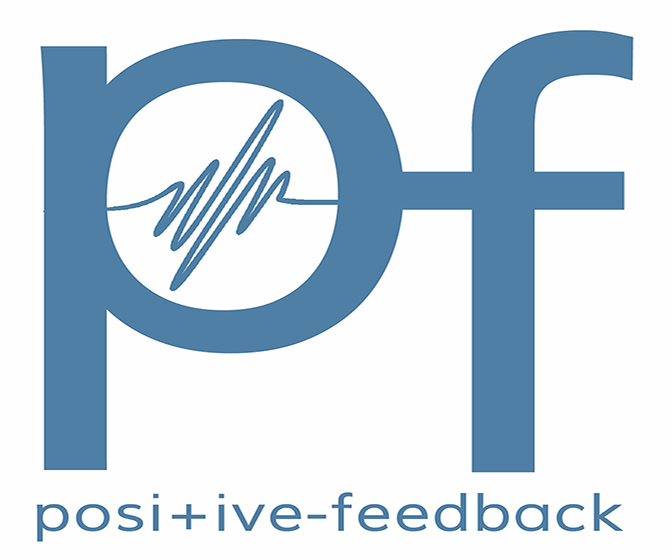

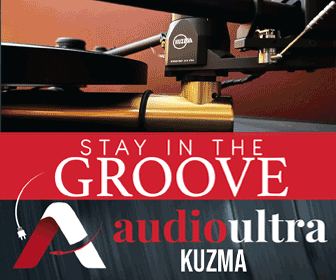
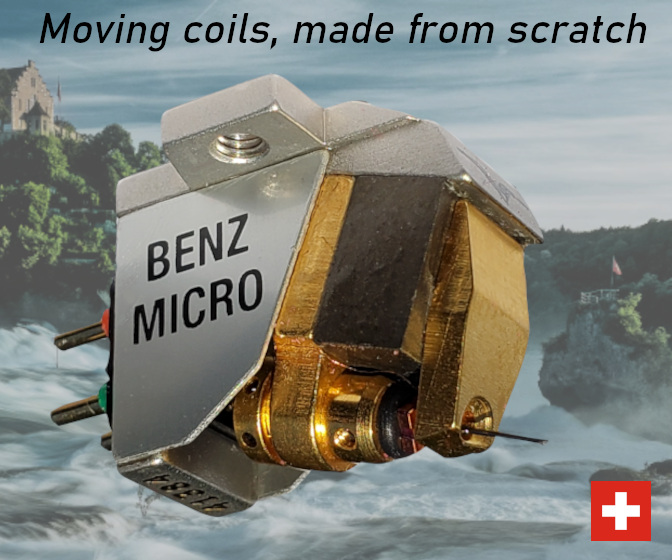

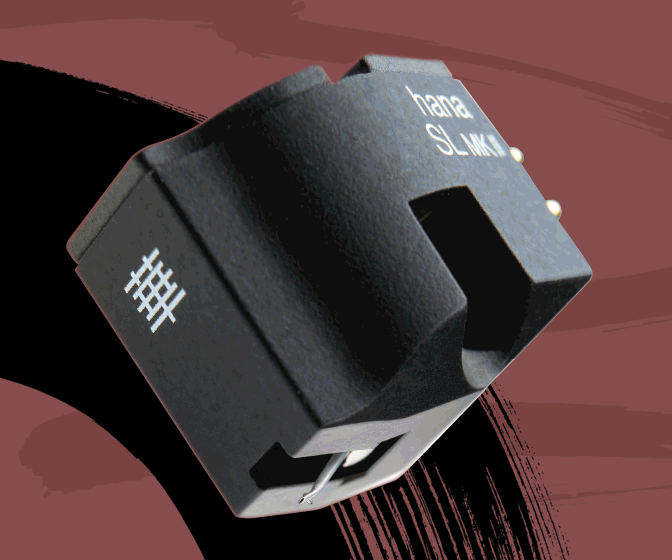
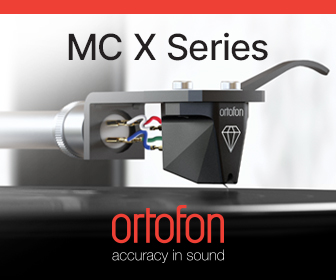
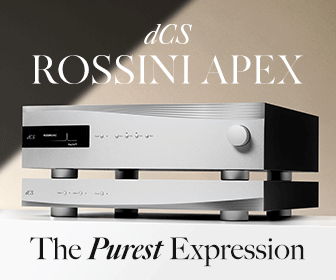
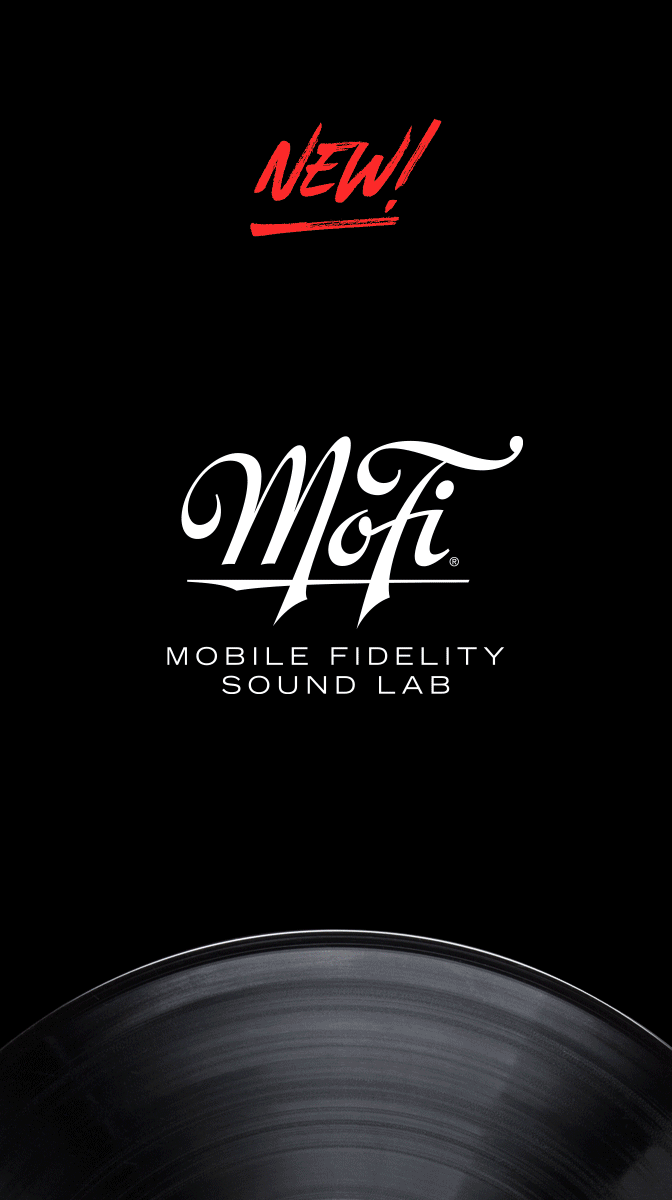

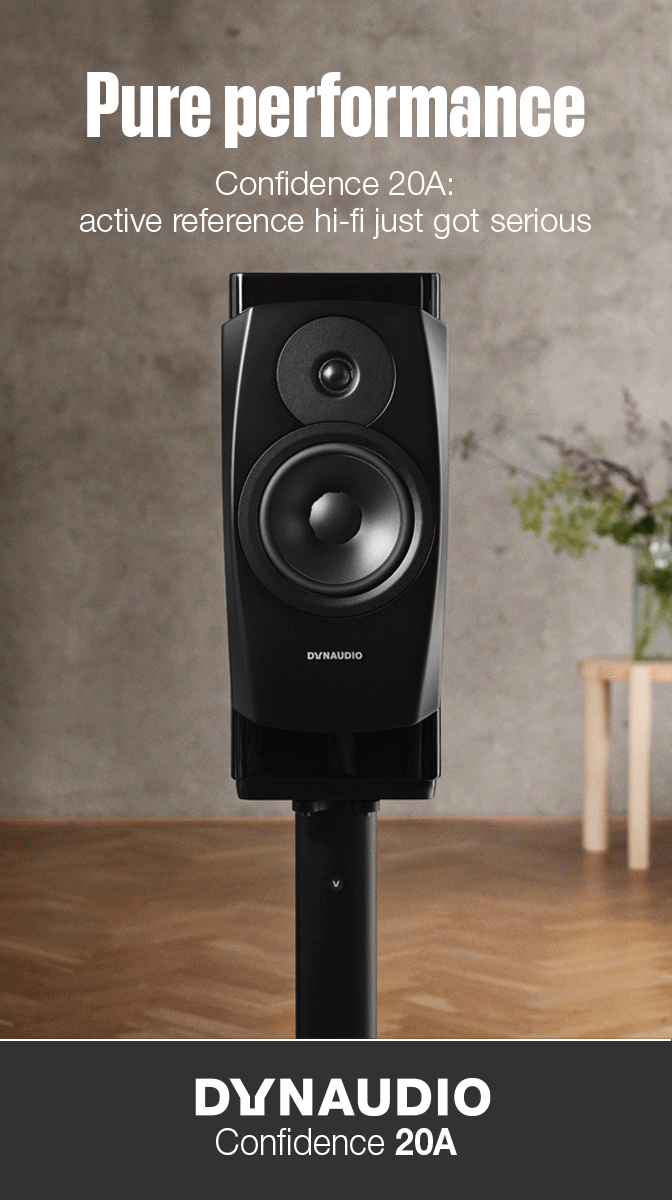

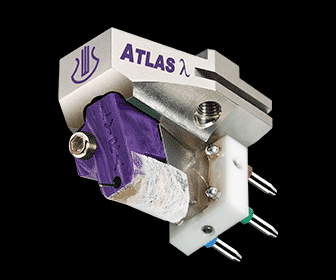

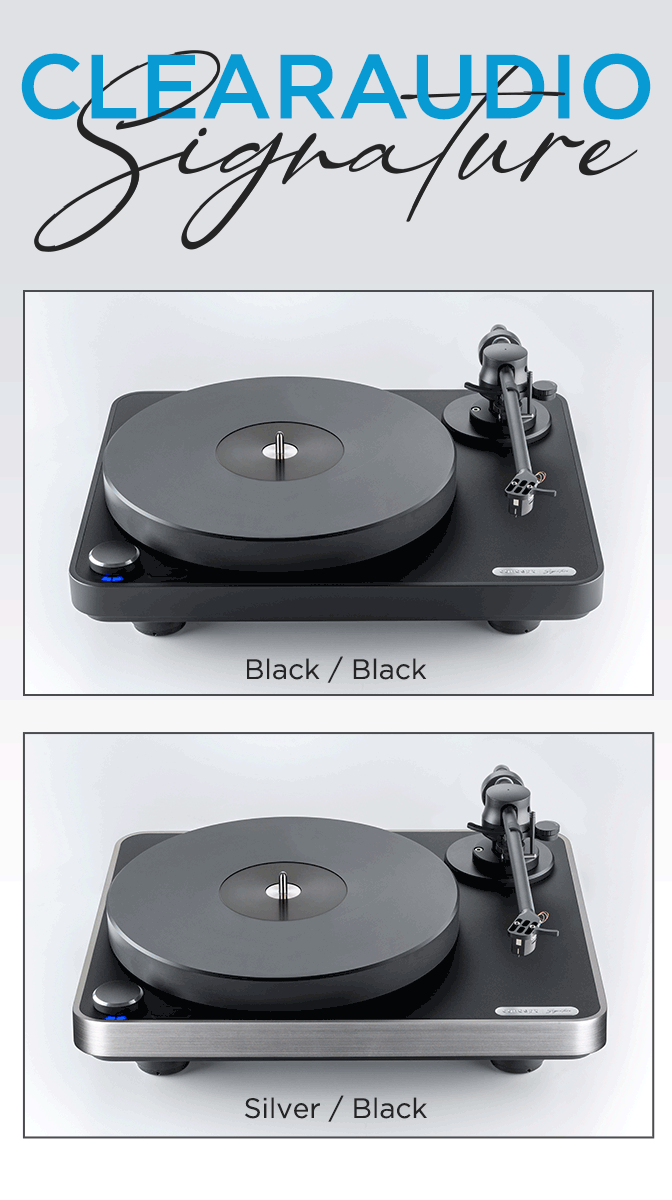
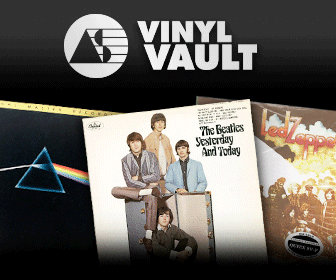
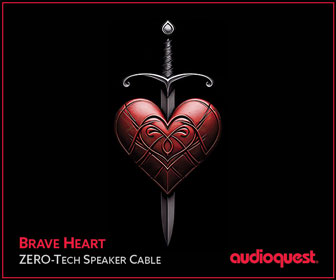
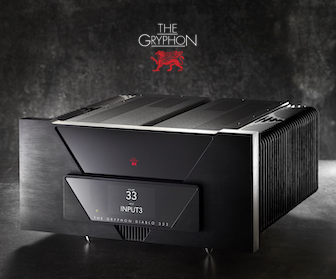
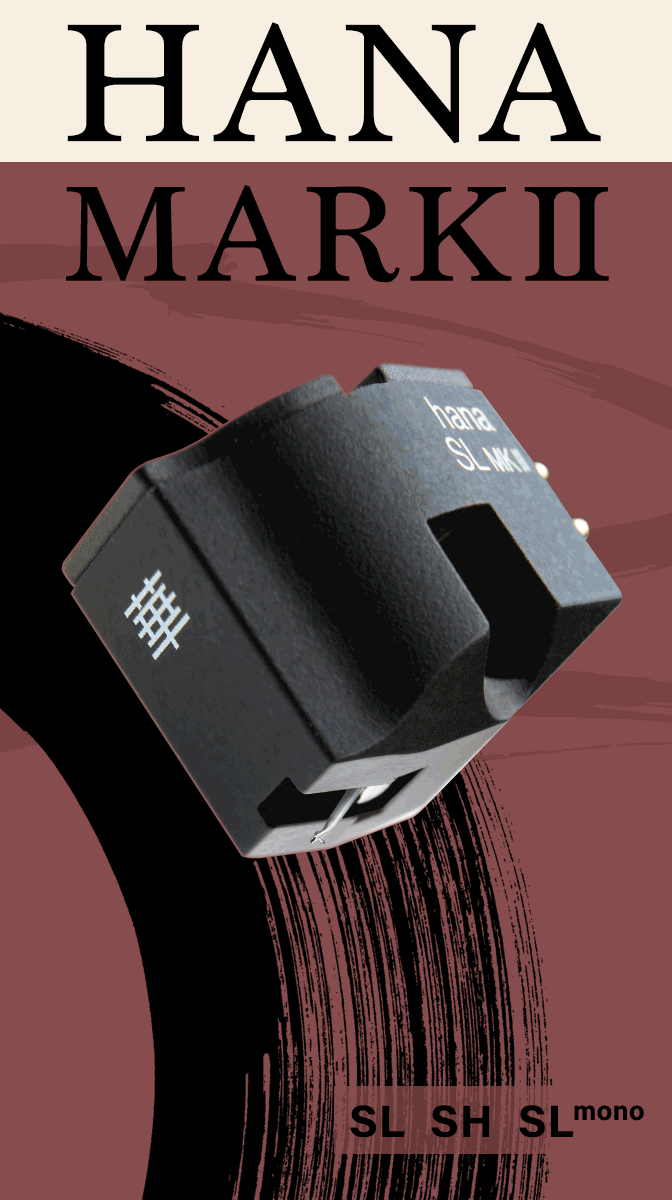


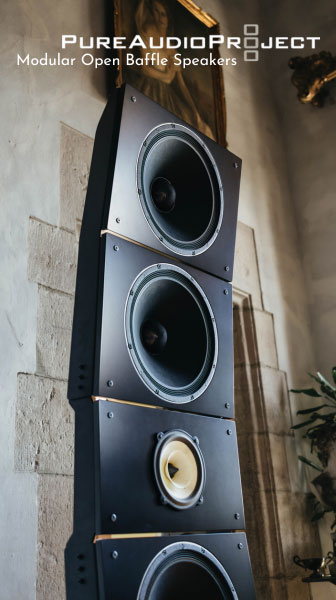






.png)








